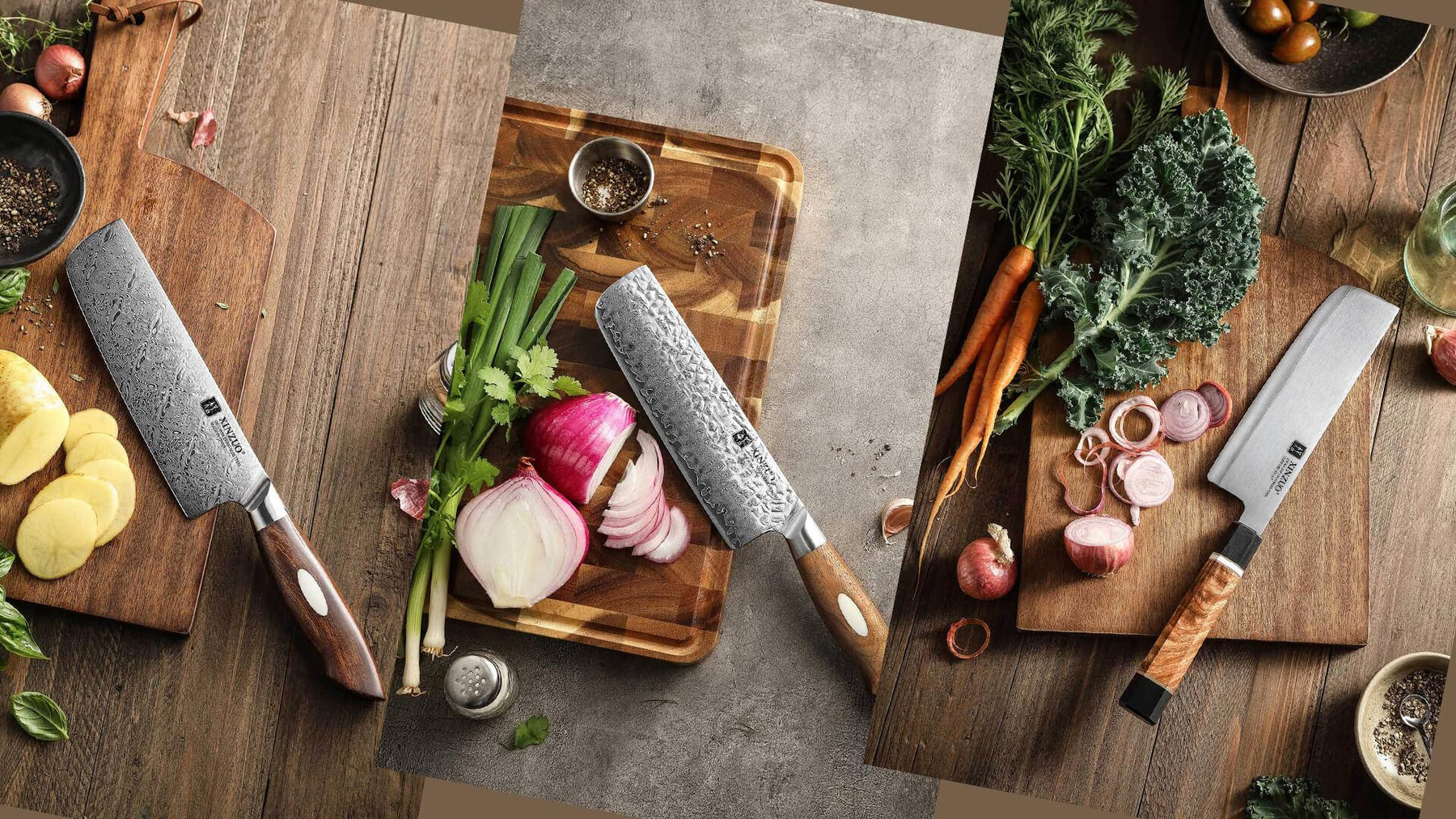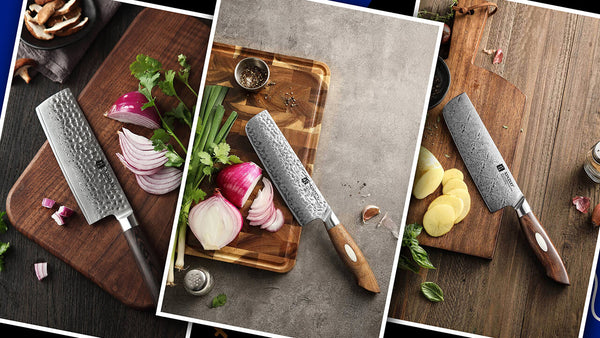
What is a Nakiri Knife Used For?
If you’re somebody who enjoys spending time in the kitchen making delicious food, then you’ll know how important it is to have excellent quality tools and appliances. Not only do they do a far better job, but they make everything significantly more enjoyable! And, one of the most important tools in any kitchen is knives, because, let’s be honest, you use them for just about everything.
A Nakiri knife is a Japanese Nakiri knife style that is specifically designed for use with vegetables. Every single component of its construction lends itself to use with veggies, making chopping, slicing, and dicing effective and efficient. It’s actually an incredibly versatile knife when it comes to working with fruit, veggies, and even herbs. However, that being said, its versatility is limited to these things – it shouldn’t be used for meat or anything that’s hard or tough. It simply isn’t a heavy-duty knife.
But, that’s okay, because a Nakiri knife can (and should) be used for just about all your veggie needs – from slicing and chopping them up to julienning and preparing your herbs. And, the reason a Nakiri knife is so good at doing all these things so well is because of its intricate and very specific construction – that is, the design of the blade and all its little component, as well as the material from which its made. Every single aspect of this knife contributes to its expert functionality.
So, if you’re interested in purchasing yourself a Nakiri knife for your kitchen and stepping up your culinary game, stick around while we tell you all about what a Nakiri knife is, what it’s used for, and its general construction and composition, so that you can find the perfect knife for your needs.
What is a Nakiri Knife?
You already have a pretty basic idea of what a Nakiri knife is – it’s a specialized veggie knife. But, there’s more to it than that! It’s known, in particular, for having a squared-off tip and straight edge.
A Nakiri knife, as you may have guessed from the name, is a Japanese-style knife that is very specific in its purpose and intended use, and, consequently, is designed accordingly. It has several features that contribute to making it so good at working with vegetables, including the fact that the knife has a straight edge, a squared-of tip, and a double bevel. The double-bevel helps avoid vegetables sticking to the blade as you slice them, and it also makes it ideal for both right and left-handed users.

There are different ways in which knives can be made, and a lot of this influences the quality of the knife. Nakiri knives may be either forged or stamped, depending on the knife maker.
Forged knives tend to be more highly regarded, as the blade of the knife goes through a full-on forging process that is more time-consuming and difficult to get right. Stamped knives, on the other hand, are a bit easier to make, especially in large volumes – the blades are cut from a sheet of material. The difference between these two methods of construction also influences the price of the overall product.
But, let’s get into the specifics, starting with an in-depth description of the construction of a Nakiri knife, one feature at a time.
The Construction of a Nakiri Knife
As we’ve said, the construction of a Nakiri knife is quite specific, even though there can still be a certain degree of variation from one knife to the next. Let’s have a closer look at the specific features of Nakiri knives that make them what they are.
- Blade Thickness: One of the most important features of Nakiri knives is that their blades are very thin – this is a feature of most Japanese knives actually. This allows for extreme precision, and thin blades and precision are really important for working with vegetables as it makes things far more effective and efficient. A thin blade means that there’s less resistance and the chances of the food sticking to the blade are also lower.
- Blade Material: As with all knives, Nakiri knife blades can be made from a variety of different materials, and this very much influences the quality and price of the knife. Typically, you’ll find that they’re made from high-carbon steel, stainless steel, or a combination of the two. The former is known for being incredibly sharp and it last boasts excellent edge retention, meaning that it’ll stay sharp for longer and you won’t have to sharpen it down regularly – thus, the knife will last far longer in general. The latter is known is particular for being resistant to corrosion which is a great property for a vegetable knife to have.
- Blade Design: As we’ve briefly mentioned, the blades tend to be thin and double-edged, as well as flat – the flatness of the blade contributes to the efficiency of shopping and slicing. They also tend to have a double bevel so that food doesn’t stick to the blade, and this also makes it ideal for both left and right-handed users.
- Blade Tip: The tip of a Nakiri knife is squared off which is generally something that chefs enjoy for use with vegetables. It allows you to cut all the way through to the cutting board without having to change the angle of your slicing or chopping, making it far more effective and efficient.
- Blade Edge: As we’ve mentioned, a Nakiri knife has a double edge, allowing for versatility and efficacy.
- Handle Material: As with most knives, the handle of a Nakiri knife can be made from just about anything – it’s more about aesthetics and personal preference. But the most important thing is the fact that the design is ergonomic, comfortable, and secure. A few of the most popular handle materials include wood, stainless steel, or composite materials, all of which have different pros and cons.
- Knife Tang: Nakiri knives may have a full or a partial tang – so it’s more about quality and price. The full tang means that the blade extends all the way into the handle, which tends to provide the most balance and stability. However, they can also have partial tang, so the blade doesn’t go all the way through the handle – this doesn’t necessarily make the quality inferior, although it’s far more likely to be cheaper and have slightly less balance.
- Handle Design: Again, the design of your handle should be all about comfort and ease of use, and this can differ from one person to the next. However, a proper Nakiri knife will have what’s called a “wa” handle which is normally made from wood and favors a pinch grip. However, it can also have a more western-style handle which can be made from just about anything and favor s a more ergonomic grip.

What is a Nakiri Knife Used For?
Best Nakiri knife use is with vegetables. Let’s have a closer look at the specific tasks that they ca be used for in relation to vegetables as well as fruit and herbs.
- Slicing: A Nakiri knife is excellent when it comes to slicing veggies, as well as fruit, and it has the ability to create precise, thin slices that many other knives would struggle to be able to do. Its straight edge and thin, sharp blade make this possible.
- Chopping: It’s great for chopping and dicing vegetables, and it does so with ease and accuracy. This is mostly due to its squared-off tip and flat blade.
- Julienning: Julienning can be difficult to execute accurately with the wrong knife, but the thin blade of the Nakiri knife makes it perfect for this – it allows you to make fine julienne cuts, especially if you’re working with something like carrots or bell peppers.
- Mincing: Two of the most important things about a knife you use for mincing is a flat blade and a sharp edge, and that’s why a Nakiri knife is perfect for this. It’s great for use with onion, garlic, and other aromatic ingredients.
- Herb Preparation: Finely chopping herbs can be difficult at the best of times, but the sharpness and thin blade of a Nakiri knife makes it your best option by far.

When it comes to Nakiri knife use, it’s excellent for anything to do with vegetables and herbs, and it can also be used to work with fruit. It’s very specifically designed to be effective and efficient when it comes to handling vegetables.
Final Thoughts on the Japanese Nakiri knife
There you have it – everything you need to know about what a Nakiri knife is, what it’s used for, and exactly what it looks like. It’s an absolute must-have if you work with vegetable on a regular basis, and we guarantee that it’ll allow you to be more precise and efficient.
Browse our selection of knives today to find the best Nakiri knife for your kitchen!


